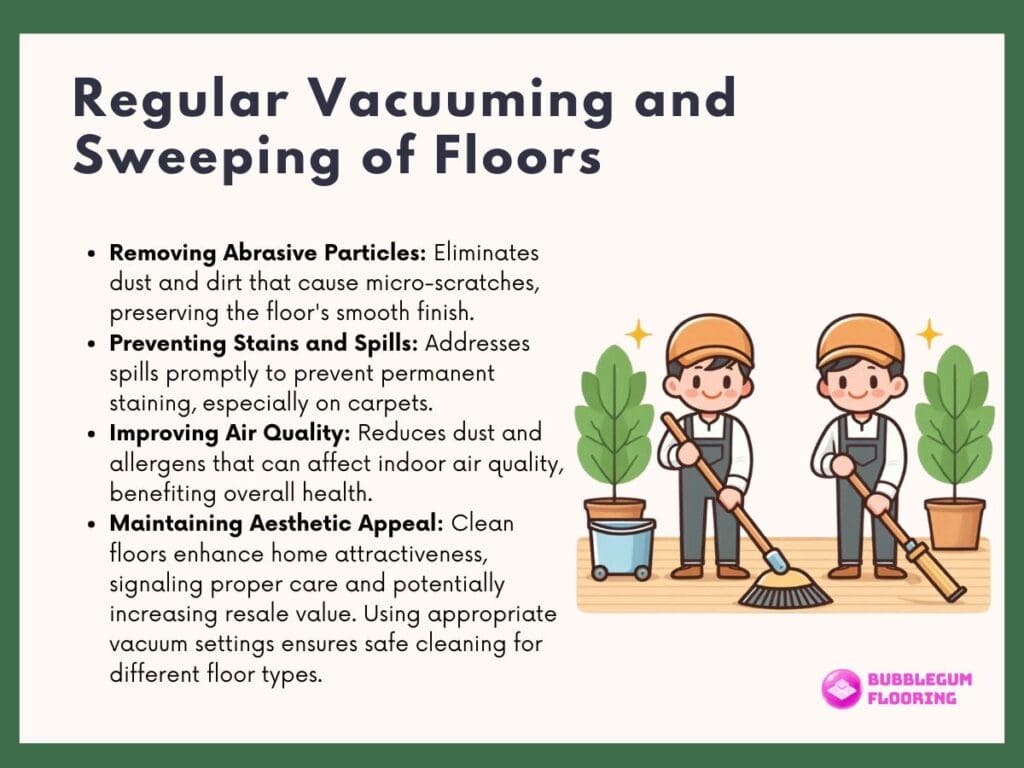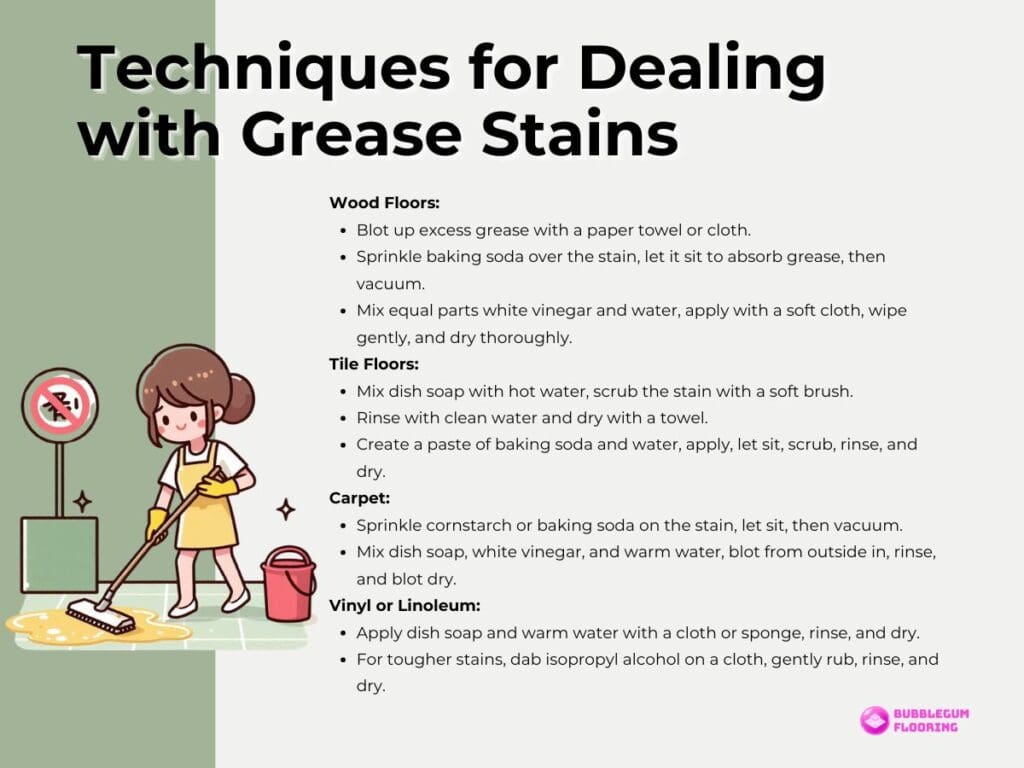Maintaining pristine floors is crucial for boosting your home’s resale value. Stubborn stains and damage can quickly diminish the appeal of any space, making it essential to address these issues promptly. From grease stains in the kitchen to everyday wear and tear, knowing how to handle floor imperfections can make a significant difference.
We’ll explore effective techniques for tackling tough stains and when it might be time to call in professionals for floor repair or replacement. Ensuring your floors look their best will not only enhance your living environment but also attract potential buyers.
Hack 1: Preventative Maintenance
When it comes to home resale value, every detail matters, and flooring is no exception. The condition of your floors can significantly impact how potential buyers perceive your home. Implementing preventative maintenance strategies can ensure your floors remain in top-notch condition, ultimately boosting your home’s resale value.
Using Doormats at Entrances
One of the simplest yet most effective ways to protect your floors is by using doormats at all entrances. Doormats serve as the first line of defense against dirt, moisture, and debris that can be tracked into your home. When people wipe their feet on a doormat before entering, they remove a significant amount of dirt and grit that could otherwise scratch and wear down your flooring over time.
For optimal protection, place a durable, high-quality doormat outside each entrance and another just inside the door. Encourage family members and guests to use these mats to keep your floors cleaner and safer. Regularly clean and shake out your doormats to ensure they continue to effectively trap dirt and debris.
Regular Vacuuming and Sweeping
In addition to using doormats, regular vacuuming and sweeping are essential components of preventative floor maintenance. Dust, dirt, and small particles can accumulate on your floors daily, leading to scratches and a dull appearance. By incorporating regular cleaning into your routine, you can keep your floors looking pristine and extend their lifespan.

1. Removing Abrasive Particles: Vacuuming and sweeping remove abrasive particles that can cause micro-scratches on your floors. Over time, these scratches can accumulate and create a worn-out look.
For hard floors, use a vacuum cleaner with a setting designed for bare floors to avoid damage. For carpets, ensure your vacuum is set to the appropriate height to effectively remove dirt without damaging the fibers.
2. Preventing Stains and Spills: Regular cleaning helps prevent stains and spills from becoming permanent. Spills can seep into the flooring material, especially on carpets, and cause unsightly stains that are difficult to remove. By promptly vacuuming and sweeping, you can address spills before they have a chance to set in.
3. Improving Air Quality: Regularly cleaning your floors also improves indoor air quality. Dust and allergens can accumulate on floors and get kicked up into the air as people walk around. Vacuuming with a HEPA filter and sweeping help reduce these particles, creating a healthier living environment for you and your family.
4. Maintaining Aesthetic Appeal: Clean floors enhance the overall aesthetic appeal of your home. Whether you have hardwood, tile, laminate, or carpet, a clean surface looks more attractive to potential buyers. Well-maintained floors signal that the home has been cared for, which can increase its resale value.
Hack 2: Spot Cleaning Techniques
When it comes to maintaining the beauty and value of your home’s floors, spot cleaning is a crucial practice. Addressing spills and stains promptly can prevent long-term damage and keep your floors looking pristine.
Effective Spot Cleaning Methods for Different Flooring Types
Different flooring materials require specific spot cleaning techniques to ensure effective cleaning without causing damage. Here are some tailored methods for various flooring types:
1. Hardwood Floors:
- Blot, Don’t Rub: For spills on hardwood floors, it’s essential to blot the spill with a clean, dry cloth instead of rubbing it. Rubbing can spread the spill and push it deeper into the wood.
- Mild Soap Solution: Mix a few drops of mild dish soap with warm water. Dampen a cloth with the solution and gently clean the affected area. Avoid using excess water, as moisture can damage hardwood floors.
- Vinegar and Water: For tougher stains, a mixture of equal parts white vinegar and water can be effective. Apply the solution with a cloth and wipe dry immediately.
2. Carpet:
- Blotting Technique: As with hardwood, blotting is crucial. Use a clean cloth or paper towel to blot the spill, starting from the outside and working inward to prevent spreading.
- Baking Soda and Vinegar: Sprinkle baking soda on the stain, then spray with a mixture of equal parts vinegar and water. Allow it to fizz and bubble, then blot with a clean cloth.
- Hydrogen Peroxide: For stubborn stains, hydrogen peroxide can be used, but test it on a small, inconspicuous area first to ensure it doesn’t bleach the carpet. Apply, let it sit for a few minutes, then blot dry.
3. Tile and Laminate:
- Warm Water and Dish Soap: For tile and laminate floors, a mixture of warm water and a few drops of dish soap can effectively clean spills. Use a damp cloth to wipe the area clean.
- Hydrogen Peroxide and Baking Soda: For grout stains on tile floors, make a paste with hydrogen peroxide and baking soda. Apply it to the stain, let it sit for a few minutes, then scrub with a brush and rinse.
- Rubbing Alcohol: For laminate floors, rubbing alcohol can be an effective cleaner. Dampen a cloth with rubbing alcohol and gently clean the stained area.
Hack 3: Reviving Dull Floors
Reviving dull floors can breathe new life into your home, making it look fresh and inviting. Over time, even the most well-maintained floors can lose their shine, but with the right techniques and tools, you can restore them to their former glory. The following will explore the causes of dull and lifeless floors, effective techniques for reviving the shine, the use of a floor buffer or polisher, and tips for maintaining the shine after reviving your floors.
Causes of Dull and Lifeless Floors
Several factors can cause floors to become dull and lifeless over time. Understanding these causes can help you take preventative measures and maintain the shine of your floors for longer.
- Dirt and Debris: Dirt and debris can scratch the floor’s surface, causing it to lose its shine. Even tiny particles can create micro-scratches that accumulate over time, dulling the finish.
- Foot Traffic: High foot traffic areas are more prone to wear and tear. The constant movement of people can wear down the floor’s finish, especially in busy households or commercial spaces.
- Cleaning Products: Using the wrong cleaning products can damage your floor’s finish. Harsh chemicals and abrasive cleaners can strip away the protective layer, leaving the floor looking dull.
- Sunlight: Prolonged exposure to direct sunlight can cause fading and discoloration, particularly in wooden floors. UV rays can break down the finish, making it look worn and tired.
- Moisture: Excess moisture can lead to water damage, which can dull the floor’s appearance. This is particularly a concern for wooden and laminate floors, which can warp and lose their shine when exposed to too much water.
Techniques for Reviving the Shine
Once you understand the causes of dull floors, you can take steps to revive their shine. Here are some effective techniques:
Deep cleaning is a great place to start. A thorough deep cleaning can remove built-up dirt and grime. Use a gentle, pH-neutral cleaner suitable for your floor type, and avoid using too much water, especially on wooden floors, to prevent damage.
Polishing can also restore the shine to dull floors. Use a high-quality floor polish designed for your specific floor type, apply it evenly, and buff it to a high shine using a soft cloth or a microfiber mop.
For floors that can be waxed, applying a fresh coat of wax can provide a protective layer and restore shine. Follow the manufacturer’s instructions for the best results. Buffing the floor can help remove scratches and restore its natural shine. This can be done manually with a soft cloth or with a floor buffer for larger areas.
Hack #4: Extending the Time Between Deep Cleans
Maintaining clean floors is essential for any home or business. While deep cleaning is crucial, it can be time-consuming and labor-intensive. Extending the time between these deep cleans can save both effort and resources. Here’s how to achieve that balance while ensuring your floors remain spotless and in great condition.
Importance of Deep Cleaning Floors Periodically
Deep cleaning floors periodically is vital for several reasons. First, it helps eliminate dirt, grime, and allergens that accumulate over time, improving indoor air quality and overall health. Regular deep cleaning also preserves the floor’s aesthetic appeal, ensuring it looks polished and well-maintained.
Moreover, it extends the lifespan of flooring materials by preventing damage from dirt particles that can scratch and wear down surfaces. Finally, deep cleaning sanitizes the floors, reducing the risk of bacterial and fungal growth, which is particularly important in high-traffic and moisture-prone areas.
Hack #5: Dealing with Stubborn Stains and Damage
When it comes to maintaining the resale value of your home, flooring plays a pivotal role. Clean, well-maintained floors can significantly boost a home’s appeal, while damaged or stained floors can detract from its value.
Addressing Stubborn Stains and Damage on Floors
Stubborn stains and damage on floors can be a homeowner’s nightmare, especially when preparing to sell a home. Whether it’s grease stains in the kitchen or other types of damage, it’s essential to address these issues promptly and effectively. Let’s delve into some techniques for dealing with one of the most challenging stains: grease.
Techniques for Dealing with Grease Stains
Grease stains are notoriously tough to remove because they penetrate deep into flooring materials. Here are some effective techniques for tackling grease stains on various types of flooring:

Wood Floors
Start by blotting up as much of the grease as possible using a paper towel or cloth. Avoid rubbing, as this can spread the stain. Sprinkle baking soda over the stain and let it sit for a few hours to absorb the grease, then vacuum it up. Mix equal parts white vinegar and water, and apply it to the stain with a soft cloth. Wipe gently and dry the area thoroughly.
Tile Floors
Mix a few drops of dish soap with hot water and scrub the stain with a soft brush. Rinse with clean water and dry with a towel. Combine baking soda and water to form a paste, apply it to the stain, let it sit for 10-15 minutes, then scrub with a brush. Rinse and dry the area.
Carpet
Sprinkle cornstarch or baking soda over the stain and let it sit for 15-30 minutes to absorb the grease, then vacuum up the powder. Mix one tablespoon of dish soap with one tablespoon of white vinegar and two cups of warm water. Blot the stain with this solution using a clean cloth, working from the outside in to prevent spreading. Rinse with water and blot dry.
Vinyl or Linoleum
Apply a mixture of dish soap and warm water to the stain with a soft cloth or sponge. Rinse and dry the area. For tougher stains, dab a small amount of isopropyl alcohol on a cloth and gently rub the stain. Rinse with water and dry.
Conclusion
Maintaining clean, undamaged floors is essential for enhancing your home’s resale value. By effectively addressing stubborn stains like grease and knowing when to call in professionals for repair or replacement, you can ensure your floors remain a strong selling point.
Proper care not only preserves the aesthetic appeal but also protects the integrity of your flooring, making your home more attractive to potential buyers. Investing time and effort into floor maintenance can lead to a higher market value, offering a significant return when it’s time to sell.


